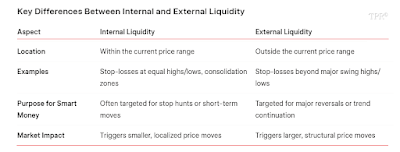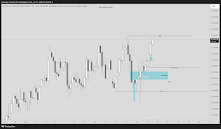There are three main tools for market analysis that you will need once and for all. No more patterns and unnecessary clutter that only hinder and bring failures. The logic of the market is very simple and based on just three main elements: Liquidity, Volume, and Inefficiency. All price action can be described using just these three concepts.
» The logic of the market is based on liquidity, volume, and inefficiency. «
► Liquidity: At the top of this chain is liquidity, the primary driver of the market. Without liquidity—without buy or sell orders—the market would come to a standstill. It's crucial to understand that while any element on the chart can provide liquidity, the key factor is the quantity: volume.
► Volume: The second most important element is volume—the foundation of all our market logic and strategy. Volume directly reflects the amount of liquidity, or money, that has entered the market.
► Inefficency: The third element is inefficiency, which arises from the influence of volume on price. Inefficiencies are graphical representations of volume at a specific moment in time, varying by time frame, and serve as tools for analyzing the chart.
Price always moves from liquidity to inefficiency and
vice versa, or from internal liquidity to external liquidity and vice
versa. Hence, when looking at any chart, the Points of Interest (POIs) are always price levels or zones where liquidity rests in the form of stop orders, unfilled, and partially filled orders, namely Fair Value Gaps (FVGs), Order Blocks, Rejection Blocks, Support & Resistance at previous highs and lows, or Fractal Points.
All these concepts and terms are briefly defined and outlined below, and explained in detail with context and chart examples in the following video.
How Fair Value Gaps (FVGs), Order Blocks (OB), and Rejection Blocks (RB) operate.
Balanced and Unbalanced State of the Market
To understand the deeper logic of inefficiencies and market movements, we need to consider two main factors. The first factor is the state of the market at a certain point in time: balanced or unbalanced. What does this mean?
When the market is in a balanced state, the volume of buys and sells is equivalent, and price hardly moves, with neither buyers nor sellers dominating the market. This is very rare and usually occurs on days with very low volatility. The second type is the unbalanced state, which is more typical of any market. This occurs when buy volume exceeds sell volume, causing price to rise, or when sell volume exceeds buy volume, causing price to fall.
Efficient and Inefficient Price Delivery
The
second factor is the efficiency of price delivery, which also comes in
two types. The first type is efficient delivery, where, in the context
of a certain market movement, both buyers and sellers are present,
allowing for a more even exchange of assets.
Efficient Price Delivery and Inefficient Price Delivery.
It is important to note that price delivery is always an unbalanced process in which one side—either buyers or sellers—dominates.
The second type is inefficient price delivery, which occurs when the exchange of assets is uneven in certain price ranges between buyers and sellers. This means that there are areas in the market where orders remain unexecuted or are only partially filled, which is a key sign of inefficient pricing. Inefficient price delivery causes a Fair Value Gap (FVG).
Fair Value Gaps (FVGs)
A
Fair Value Gap (FVG) is a formation consisting of three candles where the
shadows or wicks of the first and third candles do not overlap each other in both
bullish and bearish variants, indicating an imbalance in buying or
selling pressure.
A Fair Value Gap (FVG) is a 3 candle pattern where the shadows
of the first and third candles do not overlap, indicating an imbalance.
A FVG has three levels: the upper and lower boundaries, and the 0.5 level,
where, ideally, price action should revisit and bounce off, making it a potential entry point for a position.
Regarding the validity of the FVG when it is tested, it’s quite complex because much depends on timing. However, the key point is that price should not close below the lower boundary when the FVG is bullish and should not close above the upper boundary when the FVG is bearish. A close above the upper boundary in a bearish FVG or below the lower boundary in a bullish FVG would be considered an inverted fair value gap, which may signal a continuation of the movement. Everything else is permissible, but much depends on the context.
Examples of bearish and bullish FVGs.
Support and Resistance (SnR)
Support occurs when two candles form on the chart. The level where the bearish candle closes and the bullish candle opens is called Support. This is where buyers show activity and prevent the price from falling lower (Sell and Buy Candles).
Resistance occurs when two candles form on the chart. The level where the bullish candle closes and the bearish candle opens is called Resistance. This is where sellers show activity and prevent the price from rising higher (Buy and Sell Candles).
Order Block (OB)
A Bullish Order Block is a price movement where the Resistance level was broken with subsequent confirmation by the candle body closing above it.
A Bearish Order Block is a price movement where the Support level was broken with subsequent confirmation by the candle body closing below it.
Rejection Block (RB)
A Rejection Block is a two-candle formation where the range of shadows forms a zone of interest, and it doesn't matter which one is longer or shorter.
In the bullish variant, it begins at the Support level. In the bearish variant, it begins at the Resistance level.
Fractal Point (FP)
A Fractal Low (FL) is a three-candle formation where the minimum of the middle candle is lower than the minimums of the first and third candles. Five-candle fractals are considered potentially stronger.
A Fractal High (FH) is the opposite three-candle formation, where the middle candle has the highest maximum compared to the adjacent candles.
Dealing Range (DR)
The Dealing Range is a price movement that can be identified using two opposing fractal points (High and Low), regardless of direction. This formation displays the balance between buyers and sellers during a specific time period and helps to more clearly define potential zones of interest.
The Dealing Range is divided into two main zones - Premium and Discount with an Equilibrium level in the middle.
High Resistance Logic
High Resistance is considered a movement that has interacted with liquidity (Fractal Raid) or inefficiency (FVG rebalance) usually on the same timeframe, resulting in the formation of (OB, RB, FVG), plus a fractal point has formed as a level confirming the extreme.






























.PNG)













